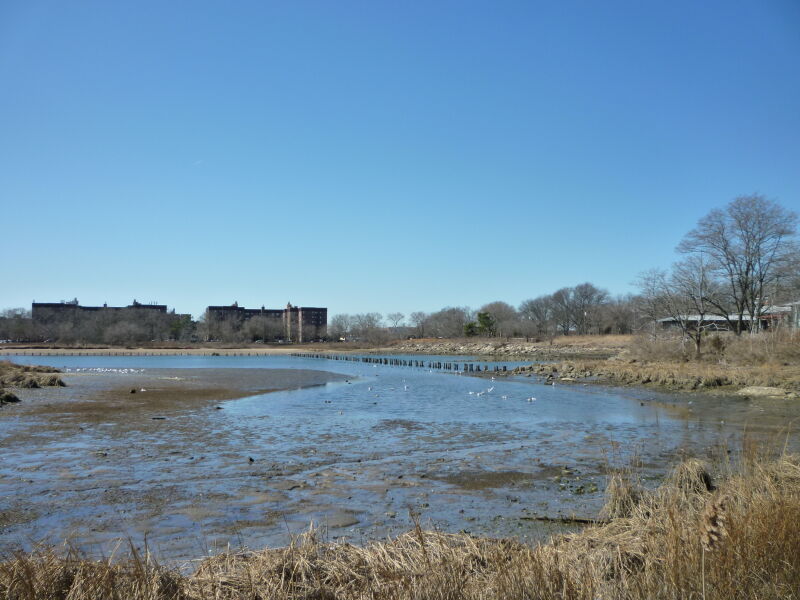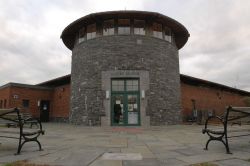Marine Park
Lenape Playground
This beautiful playground honors the Lenape, who were the original inhabitants of New York City and the surrounding territory. For thousands of years before the arrival of Europeans, the Lenape thrived living in harmony with their environment. Today this playground, part of the larger Marine Park, is home to new play equipment and other recreational facilities for the enjoyment of the whole neighborhood.
Before European colonization, loosely confederated groups of people lived all along the eastern seaboard. There were perhaps as many as 15,000 native inhabitants in what is now New York City and somewhere between 30,000 and 50,000 settled in the area between modern-day Connecticut and New Jersey. Within the five boroughs of modern New York City alone, archeologists have identified approximately 80 Lenape habitation sites and an extensive system of trails.
In their Algonquian language, Lenape means “true man” or “original people.” Rather than having well defined “tribes” or “nations,” the Lenapes organized themselves primarily as autonomous sub-groups comprised of a few dozen to several hundred people. There were many of these different groups living throughout the land that they called Lenapehoking, or “where the Lenapes dwell.” The English refered to the Lenape as the Delaware, adopted because of the river named for Lord de la Warr, for Algonquian-speaking natives lived upon its banks in Pennsylvania and New York.
The Lenape resided in a series of seasonal campsites. Their dwellings, called longhouses, were easily constructed to accommodate this nomadic lifestyle. Made of saplings and covered with sheets of bark, the crevices were plugged with clay and corn stalks. Some houses were big enough to accommodate a dozen families. Nomadic life discouraged accumulation of excess property and the overuse of any one particular plot of land, which minimized the human impact on the surrounding plants and animals. Lenape spirituality emphasized the interdependence of all life and their people thrived for thousands of years in an abundant natural environment.
The first evidence of European contact with the Lenape came with the arrival, of the French vessel La Dauphine, piloted by the Florentine explorer Giovanni da Verrazzano (1485-1528). The ship anchored just off Staten Island, in 1524, and was surrounded by several dozen small boats with occupants “clad with feathers of fowl of diverse colors.” The natives greeted the newcomers “very cheerfully, making great shouts of admiration” and were hospitable throughout the foreigners’ stay. This did not prevent Verrazzano from attempting to kidnap some of the Lenape as he left. Over the next several decades, European slave ships occasionally raided villages along the coast, leading the Lenape to view the Europeans with distrust.
As the European presence in the area grew, Lenape faced great hardship. More colonists moved in and many Lenapes drifted away, often merging with other Algonquin-speaking people further west. Those who remained fell prey to devastating epidemics of small pox and other diseases. Amid the burgeoning fur trade, competition among tribes for European patronage exacerbated intertribal conflict. On Staten Island, conflict between the native tribes and the Dutch settlers arose over issues of land ownership. Resolving these conflicts often had bloody consequences for both sides. In Brooklyn specifically the Lenape had settlements in what is now Gowanus, Sheepshead Bay, Flatlands, and Canarsie. The Canarsie Indians were one of the several different subgroups who were particularly prominent in Brooklyn.
This playground, acquired with a large part of Marine Park’s property in 1924, is part of the 798 acre Marine Park that surrounds the westernmost inlet of Jamaica Bay. It is home to new play equipment with safety surfacing, a swing set, basketball courts, baseball fields, and new handball courts thanks to $54,286 provided by Mayor Rudolph W. Giuliani. The playground also contains a distinctive sculpture of a giant rattlesnake that slithers up and down through the pavement and a tortoise emerging from a hill, watching her hatchlings that spray water to cool down children in the summertime.
Check out your park's Vital Signs
Clean & Safe
Green & Resilient
Empowered & Engaged Users
Share your feedback or learn more about how this park is part of a
Vital Park System










